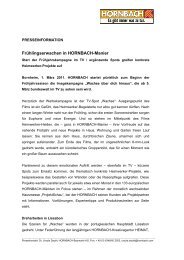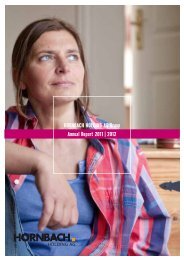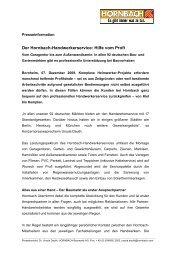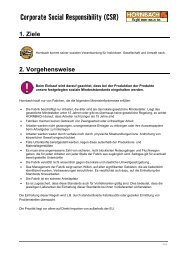Hornbach-Baumarkt-AG Group
PDF, 3,6 MB - Hornbach Holding AG
PDF, 3,6 MB - Hornbach Holding AG
- No tags were found...
Create successful ePaper yourself
Turn your PDF publications into a flip-book with our unique Google optimized e-Paper software.
76 GROUP MAN<strong>AG</strong>EMENT REPORT Outlook<br />
the process of contraction is expected to slow to around minus<br />
1% or at best even stabilize in 2013. The construction experts<br />
are confident that housing construction will regain positive<br />
territory with growth of around 2.5% in 2014.<br />
In their medium-term forecast for the period from 2012 to<br />
2015, the Euroconstruct researchers paint an overwhelmingly<br />
positive picture for seven of the countries in HORNBACH’s<br />
network. Housing construction in Germany is thus thought to<br />
have the potential for average annual growth of 2.5%, a rate<br />
only topped in Europe by Norway (plus 4.9% p.a.). Housing<br />
construction volumes are set to grow by just over one percent<br />
a year in Austria and Switzerland, and by 0.5% and 0.3%<br />
respectively in Slovakia and Sweden. For the Netherlands,<br />
plagued by a real estate crisis, the construction expects have<br />
forecast a slight reduction in housing construction work<br />
averaging 0.3% a year. With an annual contraction of 2%,<br />
new housing construction volumes in the Czech Republic are<br />
set to show clearly below-average developments. This is due<br />
in particular to rising consumer prices, falling real-term<br />
incomes, tax charges, and increased job insecurity.<br />
Notwithstanding the fragile macroeconomic backdrop, the<br />
German construction industry remains positive in its assessment.<br />
The two main construction industry associations<br />
(Hauptverband der Bauindustrie and Zentralverband des<br />
Baugewerbes) expect growth of 2% in nominal construction<br />
sales in 2013. Housing construction will remain the key<br />
growth driver for the main construction trade, with sales<br />
growth of 3.5%. According to the forecast issued by the association,<br />
commercial construction and public construction are<br />
set to show moderate nominal sales growth of 1.0% and<br />
1.5% respectively.<br />
Sector-specific opportunities<br />
The medium-term macroeconomic framework and the outlook<br />
for the construction and retail sectors also offer the DIY sector<br />
positive development opportunities overall in the countries<br />
where we operate. What's more, DIY store and garden center<br />
operators stand to benefit in future from specific megatrends<br />
harboring various degrees of potential in individual country<br />
markets in terms of rising demand for products and services<br />
relating to construction, renovation and gardens. Looking<br />
forward, developments are crucially dependent on both the<br />
macroeconomic framework and consumer and business confidence<br />
levels remaining stable. In assessing future sectorspecific<br />
opportunities, particular importance has to be accorded<br />
to downside risks, such as those resulting from any<br />
potential further escalation in the European sovereign debt<br />
crisis.<br />
Based on the key factors outlined above, such as employment<br />
totals, income levels, consumer confidence, and developments<br />
in the construction industry, the European DIY sector is<br />
placing its hopes in the prospect that, following the economic<br />
setback suffered in the second half of 2012, customer demand<br />
will gradually recover in the course of 2013 and 2014.<br />
IFH Retail Consultants expect the aggregate market volume<br />
for all DIY stores and garden centers in EU 27 countries to<br />
grow by between 0.5% and 0.7% in 2013 (2012: minus 0.5%).<br />
The German sector is slightly more optimistic in its assessment<br />
of its prospects for 2013. The BHB sector association<br />
thus expects to see a low level of nominal sales growth ranging<br />
between 1.0% and 2.0%. The association basically saw<br />
potential for sales growth in garden product ranges, which<br />
due to weather conditions were in less demand than usual in<br />
2012. Furthermore, the BHB hoped to see growth momentum<br />
from private housing construction. Given that the winter had<br />
large parts of Europe and Germany firmly in its grip until well<br />
into April, the annual performance of the sector in 2013 will<br />
crucially depend on a strong start to the seasonal business in<br />
the second and third calendar quarters.<br />
In the hunt for growth factors, one key aspect of relevance to<br />
the entire European construction and modernization sector is<br />
the great need for solutions in terms of energy-saving building<br />
technology and energy efficiency and of contemporary<br />
interior fittings. Overall, we believe that the outlook is favorable<br />
for increasing sales and earnings in the DIY sector in<br />
Germany and abroad. These growth prospects are backed up<br />
by, among other factors, the megatrends briefly described<br />
below.











